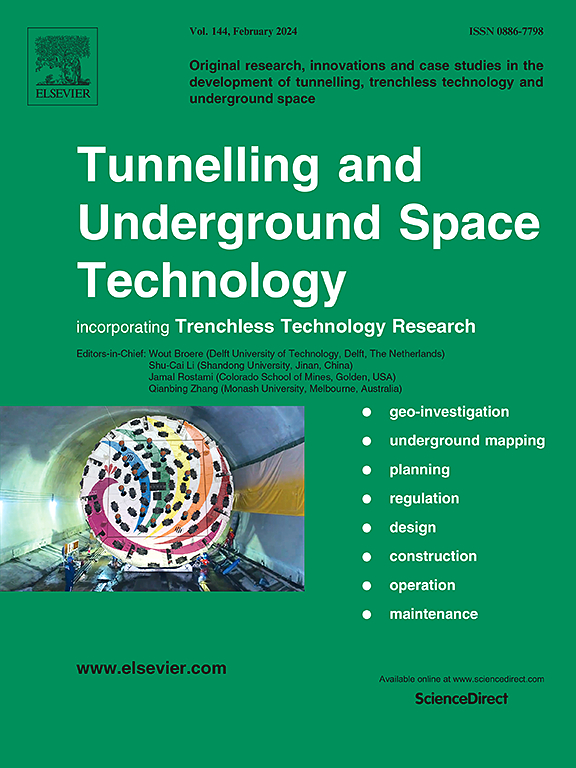GFRP筋加固工程地聚合物复合盾构隧道管片抗弯性能设计方法
IF 6.7
1区 工程技术
Q1 CONSTRUCTION & BUILDING TECHNOLOGY
引用次数: 0
摘要
为了提高盾构隧道管片的耐久性和抗裂性,引入了玻璃纤维增强聚合物(GFRP)钢筋增强工程地聚合物复合材料(EGC)管片,简称EGC- frp管片,以替代传统的钢筋混凝土管片。对EGC-FRP管片的抗弯性能进行了试验研究。分析了EGC和配筋率的影响。此外,对EGC-FRP管片进行了基于有限元分析的数值研究。结果表明:在拉伸荷载作用下,EGC比混凝土裂缝多,裂缝宽度小,且由于EGC中含有纤维,开裂后仍有残余强度,导致EGC与GFRP筋具有较强的协同加载能力;在相同配筋率下,EGC-FRP段的最大裂缝宽度减小了66.11%。同时,EGC段的抗弯强度、挠度和开裂后刚度均高于混凝土段。其中,极限抗弯强度较混凝土段提高96.44%。根据试验结果建立的有限元模型与试验数据具有较好的相关性。采用该模型分析了不同配筋率下EGC-FRP段的抗弯性能。最后,提出了EGC-FRP管片抗弯强度和挠度的计算方法。本文章由计算机程序翻译,如有差异,请以英文原文为准。
Design approach for flexural properties of engineered geopolymer composite shield tunnel segments reinforced with GFRP bars
To improve the durability and crack resistance of shield tunnel segments, glass fiber-reinforced polymer (GFRP) bars reinforced engineered geopolymer composite (EGC) segments, referred to as EGC-FRP segments, were introduced as a replacement for conventional steel reinforced concrete segments. Experimental study on flexural properties of EGC-FRP segments was conducted. Effects of EGC and reinforcement ratio were analyzed. In addition, a numerical investigation of EGC-FRP segments based on finite element (FE) analysis was performed. The results showed that EGC has more cracks and a smaller crack width than concrete under tensile load and has residual strength after cracking due to the fibers in it, which leads to strong synergistic loading ability between EGC and GFRP bars. The maximum crack width of the EGC-FRP segment is reduced by 66.11% under the same reinforcement ratio. Meanwhile, EGC segments exhibited higher flexural strength, deflection, and post-cracking stiffness than those of the concrete segment. In particular, the ultimate flexural strength is increased by 96.44% compared to that of the concrete segment. A FE model developed based on the experimental results showed a good correlation with the test data. The model was used to analyze the flexural behavior of EGC-FRP segments with different reinforcement ratios. Finally, calculation methods for the flexural strength and deflection of EGC-FRP segments were proposed.
求助全文
通过发布文献求助,成功后即可免费获取论文全文。
去求助
来源期刊

Tunnelling and Underground Space Technology
工程技术-工程:土木
CiteScore
11.90
自引率
18.80%
发文量
454
审稿时长
10.8 months
期刊介绍:
Tunnelling and Underground Space Technology is an international journal which publishes authoritative articles encompassing the development of innovative uses of underground space and the results of high quality research into improved, more cost-effective techniques for the planning, geo-investigation, design, construction, operation and maintenance of underground and earth-sheltered structures. The journal provides an effective vehicle for the improved worldwide exchange of information on developments in underground technology - and the experience gained from its use - and is strongly committed to publishing papers on the interdisciplinary aspects of creating, planning, and regulating underground space.
 求助内容:
求助内容: 应助结果提醒方式:
应助结果提醒方式:


